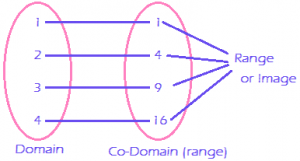Let f be a relation from A into B then {x ϵ A: (x, y) ϵ R} is codomain of f and {y ϵ B: (x, y) ϵ f} is called range of f
Domain: The domain is input values
Range: The resultant value is called range
Ex: if f = {(a, b), (c, d), (e, f)} then domain f = {a, c, e} and range f = {b, d, f}
Co-domain: The “co-domain” of a function or relation is a set of values that includes the Range as described above, but may also include additional values beyond those in the range
Ex: Ex:
Ex: Above image having the domain and range the domain is input value and output is range
Above image having the domain and range the domain is input value and output is range
Example: A simple function like f(x) = x2 can have the domain (what goes in) of just the counting numbers {1, 2, 3, …}, and the range will then be the set {1, 4, 9, …}
Input is {1, 2, 3, …} = domain
Output is {1, 4, 9, …} = range![]() And another function g(x) = x2 can have the domain of integers {…, -3, -2, -1, 0, 1, 2, 3, …}, in which case the range is the set {0, 1, 4, 9, …}
And another function g(x) = x2 can have the domain of integers {…, -3, -2, -1, 0, 1, 2, 3, …}, in which case the range is the set {0, 1, 4, 9, …}![]() Domain and range of trigonometric function
Domain and range of trigonometric function
| Trigonometric functions | Domain |
Range |
|
sinx |
(-∞, ∞) | [1, -1] |
| cosx | (-∞, ∞) |
[1, -1] |
|
tanx |
R – {(2n + 1)pi/2 | (-∞, ∞) |
| cotx | R – npi |
(-∞, ∞) |
|
cosecx |
R – npi | (-∞,-1] È [1,∞) |
| sec | R – {(2n + 1)pi/2 |
(-∞, -1] È [1, ∞) |
Ex: Find the domain and range of the real function f defined by f(x) = 4 – x/ x – 4
Sol: Given that f(x) = 4 – x/ x – 4
f (x) = – (x – 4)/ (x – 4) take a common”– “
f (x) = -1
The range of f(x) is {-1}
Domain is x – 4 ≠ 0
x ≠ 4
The domain is x ϵ R – {4}
Inverse Function: Let f be defined a function from A to B such that for every element of B their exist a image f, f: A → B is a function then {(y, x)} ϵ B x A : (x, y) ϵ f } is called inverse function.it is denoted by f-1.
Ex: if A = {1, 2, 3} and B = {a, b, c} then f : {(1, c), (2, b), (3, a)} is bijection from A into B and f-1 = {(a, 3), (b, 2), (3, a)} is bijection from B into A.
Let us start with an example:
Here we have the function f(x) = 2x + 3, written as![]() The Inverse Function goes the other way
The Inverse Function goes the other way So, the inverse of f(x) = 2x + 3 is written
So, the inverse of f(x) = 2x + 3 is written
f-1 (y) = \(\frac{\left( y\,-\,3 \right)}{2}\)
Ex: The cool thing about the inverse is that it should give us back the original value:![]() When the function f turns the apple into a banana. Then the inverse function f-1 turns the banana back to the apple
When the function f turns the apple into a banana. Then the inverse function f-1 turns the banana back to the apple
